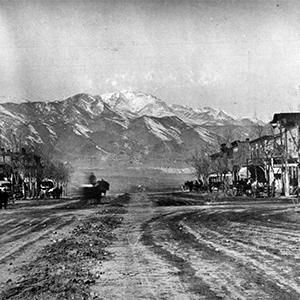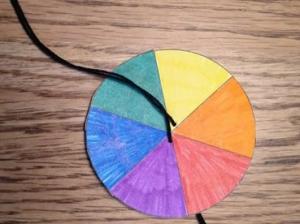Categories
Every March, Women's History Month is celebrated. Here's is a children's booklist of great books at PPLD. Click on the pdf link below.
A look at Colorado Springs history as the city celebrates a sesquicentennial
Colorado Springs resides on land inhabited for thousands of years by indigenous peoples, including the Ute, Cheyenne, and Arapaho Tribes. Artifacts found at Garden of the Gods, one of Colorado Springs’ most beautiful natural attractions, date back an astonishing 3,500 years.
Military expedition leaders such as Major Stephen H. Long and Lieutenant Zebulon Pike later explored the area in the early 1800s.
A gold rush that began in 1858 and peaked in ’59 brought prospectors through the area, but they did not settle here. “The Pikes Peak or Bust Gold Rush is a deceiving name,” explains Matt Mayberry, director of the Colorado Springs Pioneers Museum. “The gold wasn't here. It took 30 more years until the discovery of gold in Cripple Creek.”
“People coming across the country could see Pikes Peak early on and had heard about it for years,” elaborates Pikes Peak Community College Professor of History Katherine Sturdevant. “So they came here and then had to veer north. The ‘59ers were heading to the Central City-Blackhawk area, but the mountain was sort of a beacon for gold seekers.”
Colorado City (now called Old Colorado City) was founded in 1859 as a supply hub for miners heading to the gold field.
However, the city we call Colorado Springs officially began 150 years ago. At 8 a.m. on July 31, 1871, the first stake for a new town was driven at what became the southeast corner of Pikes Peak and Cascade Avenues.
GENERAL AND “QUEEN” PALMER
The founding of the town sprang from the vision of Civil War veteran General William Jackson Palmer. He was traveling between Pueblo and Denver in 1869 when he wrote in a letter, "At Colorado City, the Garden of the Gods, we stopped to breakfast. Near here are the finest soda springs and the most enticing scenery. I am sure there will be a famous summer resort here soon."
Palmer also saw an opportunity for a southward railroad route out of Denver, which was about to be connected to the Kansas Pacific Railway from the east.
“Railroads were his first love,” says Mayberry. “And you can't have railroads as a business venture in the West without having communities to serve. Colorado Springs is part of that formula.”
Soon thereafter, Palmer formed the Rio Grande Railway Company and the Colorado Springs Company. Construction on the railway began in January 1871, the first stake was driven in July, and in October the railway reached the new town.
“Colorado Springs was a product of the utopianism of the Eastern, upper-middle and upper classes,” says Sturdevant, “but it was also a business man's plan.”
“He didn't want this to be a boomtown. He wanted it to be a resort,” adds Mayberry. “Colorado Springs was to be the finest place in the west to build a home.”
Such a place would need parks, and Palmer included a city park (now known as Acacia Park) in the original town plot. He later gifted additional land that became Monument Valley Park and Palmer Park.
His wife, Mary Lincoln “Queen” Mellen Palmer, also played an important role in the town’s early days. “She is deserving of a lot of credit,” says Mayberry. “Especially establishing the school system and creating a sense of place in Colorado Springs.”
Queen Palmer taught at the first free school in town, which she opened on Nov. 13, 1871.
SPENCER AND JULIE PENROSE
“As Palmer is beginning to step off the stage,” says Mayberry, “Spencer Penrose steps on and takes our history into a different phase. He's more of a capitalist than Palmer was. Even though Palmer was an industrialist, he didn't have the same kind of drive for wealth that Penrose did.”
After making a fortune from gold and copper mines in Cripple Creek and Utah, Spencer married Julie Villiers Lewis McMillan in 1906.
Penrose had already built The Broadmoor, Pikes Peak Highway, and Cheyenne Mountain Zoo when the El Pomar Foundation was formed in 1936. The Foundation has since distributed over $500 million in grants. “That boils down to the efforts of Julie Penrose making sure that some of that wealth was available for the good of the community,” explains Mayberry.
WINFIELD SCOTT STRATTON
Winfield Scott Stratton also made a fortune in mining, hitting gold in Cripple Creek on the Fourth of July 1891 after spending 20 years as a carpenter. “He's chasing a dream all his life, and then he finally gets it. It's a story of having a wolf by the tail. You can't let go, but you can't keep holding on either,” says Mayberry. “He's plagued by wealth toward the end of his life,” with people constantly demanding money from him.
He donated land for Colorado Springs City Hall and the Mining Exchange building and paid to construct the El Paso County Courthouse (now home to the Pioneer Museum).
He also bought the town’s trolley system and spent $2 million to help Colorado Springs develop one of the top street railway systems in the country. (The streetcar system was replaced in 1931 by the Colorado Springs Bus Company.)
Stratton left a majority of his fortune to build the Myron Stratton Home, a free home for people who are "without means of support, and who are physically unable by reason of old age, youth, sickness, or infirmity to earn a livelihood." The home continues to help people to this day.
THE ARTS
“Art is foundational to Colorado Springs,” says Mayberry. “The scenic beauty of the region attracted photographers and artists like William Henry Jackson and Thomas Moran. And there was economic potential to being an artist in Colorado Springs. You could capture the scenery, and then had audiences to commission that work.”
In 1919, Broadmoor Art Academy opened in the former home of Spencer and Julie Penrose, and soon helped Colorado Springs became nationally known as a center for the arts. In 1936, the Colorado Springs Fine Arts Center (FAC) opened at the same location. Alice Bemis Taylor donated art to the FAC collection, which also included works by Van Gogh, Rembrandt, and Picasso.
“We had an influx of people, which you could call an artist colony or literary colony,” says Sturtevant. “They were also friends with Julie Penrose, and she supported this artistic activity.”
POLITICAL ACTIVISM
“Colorado Springs was a place with many forward-thinking women who would make it a center for the women's suffrage movement,” says Sturdevant.
Suffragist Caroline Spencer founded the Women's Club of Colorado Springs and the Civic League. Alongside Alice Paul, she picketed the White House in 1917 and was incarcerated for seven months as a result.
Gretchen McRae is another notable Colorado Springs resident who worked for equality. A Black woman and civil rights activist, McRae wrote and edited publications such as her pamphlet Dedicated to the Lowliest Man and A Free Republic, a national magazine in the late 1930s.
In her own way, Fannie Mae Duncan was also an activist.
“Gretchen is trying in a bold-faced way to be an activist about equality, using the printed word primarily,” says Sturdevant. “Whereas Fannie Mae is trying to run a business.”
That business was the Cotton Club, where a sign famously read, “Everybody Welcome.” At a time when some places still refused to serve Blacks or required they use a separate entrance, customers of all skin colors came to Duncan’s club to enjoy music by such luminaries as Etta James, Louis Armstrong, Billie Holiday, and Duke Ellington.
MILITARY
Camp Carson opened just south of Colorado Springs in 1942, soon after the start of World War II. In addition to housing and training soldiers, it also held prisoners of war. At one point, Camp Carson held about 9,000 POWs, mostly Italian and German, many of whom were put to work in the nearby agricultural and logging industries. It was renamed Fort Carson in 1954, and has been home to several divisions over the years. Many soldiers have also trained at the nearby Piñon Canyon Maneuver Site.
Also in 1942, an Army Air Base opened near Fort Carson to train soldiers for photographic reconnaissance missions. Its airfield was named Peterson Field.
Ent Air Force Base opened at the site currently occupied by the Olympic Training Center in 1952. When Ent closed in 1975, nearby Peterson Field was designated Peterson Air Force Base.
In 1954, famous aviator Charles Lindbergh was named to an advisory commission to determine the future site of the Air Force Academy. Colorado Springs was on the short list, so Lindbergh went to Peterson Field and “asked to rent an airplane,” recounts Rick Sturdevant, Kathy’s husband and Air Force deputy command historian. “Lindbergh was asked, ‘Well, do you have a pilot's license?’ And he had a pilot's license signed by one of the Wright Brothers. After the guy recovered, he rented the plane to Lindbergh, who flew up and down the Front Range to see what the air currents would be like and if it would be feasible and safe for people to learn how to fly and do a lot of practicing right here along the Front Range.” Colorado Springs went on to become home to Air Force Academy cadets in 1958.
North American Aerospace Defense Command, also known as NORAD, was initially headquartered at Ent Air Force Base in 1957, then was housed in the Chidlaw Building, before moving into a bunker excavated into Cheyenne Mountain. This Space Defense Center and the Combat Operations Center became fully operational in 1967.
In 1985, Falcon Air Force Station (now Schriever Air Force Base) opened and housed the 2nd Space Wing and continues to support space operations, including Department of Defense satellites.
The military presence in and around Colorado Springs has contributed more than the obvious economic impact. “An underappreciated aspect is what it does to changing the diversity of the community and bringing in more diverse residents,” says Mayberry.
THE FUTURE
“Colorado Springs, because of our rather vague founding vision of being a great place to live, we've been required to constantly reinvent ourselves,” says Mayberry. “It’s fascinating to see how we've tried to make ourselves relevant to respond to changes in the economy to look for the next best thing.
“One hundred and fifty years. You don't celebrate that every day. What we need to do, as (Mayor John Suthers) says, is be good ancestors for whoever's coming after us. So, for the 200th anniversary, when somebody is looking back at what we did, they see we've created value and we set the community up to be successful. I don't want (the Sesquicentennial) to just to be about the past. I think it's about evaluating and assessing where we want to go in the future. And then challenging us to make those decisions and go.”
COS@150
In honor of Colorado Springs’ upcoming sesquicentennial anniversary, the Colorado Springs Pioneer Museum is exploring our community’s history and through 150 objects.
PPLD Regional History Series
The story of Colorado Springs and the Pikes Peak region is far too interesting and complex to fit into a lone magazine article. Luckily, Pikes Peak Library District has published a series of books examining our rich history. Titles include:
Take and Makes for this project will be available starting this Friday, March 12, 2021.
Watch this project at: https://youtu.be/8avBll-4qnc?list=PLMEg2Dd0dSFctLfDQxsL5SmuE8zkwQFmu
Supplies:
Materials included in kit: circle template, cardboard, piece of string about 36”
Materials needed from home: crayons, colored pencils or markers, scissors, glue stick, sharp pen or pencil (to poke holes)
Directions:
- Take template of color wheel or print out a copy below.
- Color in the sections red, orange, yellow, green, blue, and purple. For an accurate color wheel, red should be opposite green, yellow opposite purple, and blue opposite orange.
- Cut out your circle template.
- Glue your circle to the piece of cardboard and cut it out again.
- Carefully poke two holes in the center of the color wheel, side by side.
- Thread your string through both holes, then tie the ends in a knot.
- Hold each end of the string. The cardboard circle should be about midway between the ends. Wind the string by spinning the wheel in a motion similar to a twirling a jump rope.
- Gently pull the string tight to get the wheel spinning. If you continue moving your hands in an in and out motion, the circle should continue to spin.
Explanation:
As the wheel spins, what do you notice about the colors? The colors disappear!
As the wheel is spinning fast, your eyes blend the colors together and the color wheel looks white.
White light, like sunlight, is made of all the colors in the rainbow. When light hits a colored object, most of it is absorbed and only one color is reflected. A red object, for example, absorbs almost the full spectrum of light, reflecting red only. When the color wheel was spinning fast enough, the colors changed faster than your eyes could see the individual colors and send the signals to your brain, so the reflections of all of the colors blended together and you saw white light!



 Ruth Holley Library will be temporarily closed for approximately one week starting Mon., Dec. 2 to complete roof repairs.
Ruth Holley Library will be temporarily closed for approximately one week starting Mon., Dec. 2 to complete roof repairs.

